Are you a foodie or fascinated by K-culture? If so, you may have heard of delicious Korean foods like Kimchi, BBQ, Japchae, and Ramen.
There is so much more to it beyond these usual suspects. South Korea is a country with a highly diverse and impressive culinary culture.
The list of fresh, fluffy, flavorful, and fantastic Korean dishes is endless. They are also delightful, easy-to-cook, and offer a perfect blend of traditional and modern recipes that fits into every ‘try-it’ list.
If you are here for Korean foods, you’re in luck. This list of our 50 best Korean recipes guide has been cooked up just for you to make you fall in love with them.
Without rambling for too long, let’s dive in!
TABLE OF CONTENTS
- About Korean Dishes
- Why is K-food so popular worldwide?
- 50 Must-Try Iconic South Korean Foods
- 1. Kimchi (김치)
- 2. Hotteok (호떡)
- 3. Sundubu-jjigae (순두부찌개)
- 4. Naengmyeon (냉면)
- 5. Tteokbokki (떡볶이)
- 6. Gamja jorim (감자조림)
- 7. Bingsu (빙수)
- 8. Japchae (잡채)
- 9. Haemul Pajeon (해물파전)
- 10. Bibimbap (비빔밥)
- 11. Gyeongdan (경단)
- 12. Hobakjuk (호박죽)
- 13. Soondae (순대)
- 14. Bossam (보쌈)
- 15. Bulgogi (불고기)
- 16. Baechu-doenjangguk (배추된장국)
- 17. Seolleongtang (설렁탕)
- 18. Hwajeon (화전)
- 19. Dasik (다식)
- 20. Samgyetang (삼계탕)
- 21. Mandu (만두)
- 22. Chimaek (치맥)
- 23. Chueotang (추어탕)
- 24. Gyeran Mari (계란말이)
- 25. Kimchi Jjigae (김치찌개)
- 26. Tteokguk (떡국)
- 27. Gyeran-ppang (계란빵)
- 28. Kongguksu (콩국수)
- 29. Ganjang gejang (간장게장)
- 30. Gopchang (곱창)
- 31. Gamjatang (감자탕)
- 32. Nakji Bokkeum (낙지볶음)
- 33. Sikhye (식혜)
- 34. Budae Jjigae (부대찌개)
- 35. Samgyeopsal (보쌈)
- 36. Kalguksu (칼국수)
- 37. Bindaetteok (빈대떡)
- 38. Omija Cha (오미자 차)
- 39. Agujjim (아구찜)
- 40. Jjajangmyeon (짜장면)
- 41. Gyeran Jjim (계란찜)
- 42. Yakgwa (약과)
- 43. Songpyeon (송편)
- 44. Jjambbong (짬뽕)
- 45. Gimbap (김밥)
- 46. Dubu Jorim (두부조림)
- 47. Galbijjim (갈비찜)
- 48. Dotori-muk (도토리묵)
- 49. Injeolmi (인절미)
- 50. Dalgona Candy (달고나)
- Final Words on Top Korean Foods Guide
About Korean Dishes

Koreans have a remarkable sense of pride and passion for food. Given the wide diversity of Korean cuisine, it’s no surprise that Koreans are foodies.
For Korean people, food extends beyond a source of nourishment; it’s an experience and a way of expressing love for their heritage and people.
Every cuisine has a unique story to tell. This rings true with Korean foods, especially, which has evolved over the centuries. This reflects changes in culture, tradition, and economy.
Traditional Korean foods include five colors — blue, red, white, black, and yellow. These represent the five attributes of life and are thought to be essential for living a healthy and prosperous life.
Since Korea has four distinct seasons, the food changes to reflect the seasonal availability of ingredients. In Korean tradition, it is common to cool down and revitalize one’s energy with protein-dense meals.
In contrast, high-nutrition fermented foods are prepared and enjoyed throughout the freezing winter. When spring arrives, Koreans enjoy dishes that incorporate a wide range of seasonal greens into the recipes.
Koreans love their side dishes. The more, the merrier rings true with their cuisine.
Most Korean meals come with many side dishes, known as banchan (반찬). Common to the Korean culture, they are communal and complement and enhance the overall dining experience.
Why is K-food so popular worldwide?
The popularity of K-wave began in the 1990s. First, it started with K-dramas, followed by K-movies and K-pop worldwide.
And now, it contributes to the spread of Korean cuisine and the overall Korean lifestyle like K-beauty. And that’s why there has been an increasing global trend of Korean-style restaurants and food joints in the last few years.
Besides the growing trend of Korean culture, the quality and tasty dishes also make K-food widespread.
You can relish them anytime because they are filled with spicy, bold, delicious, hearty, and crave-worthy flavors.
Since it contains lots of fibers, they are usually pretty digestive. Plus, the sweet, sour, and tangy choices satisfy your taste spectrum.
K-foods are some of the healthiest on earth. This is because it uses fruits, vegetables, and meats cooked simply without much oil.
Most Korean meals comprise highly nutritious ingredients, veggies, and proteins. They also have well-balanced carbs in noodles and rice. This all makes them suitable for health.
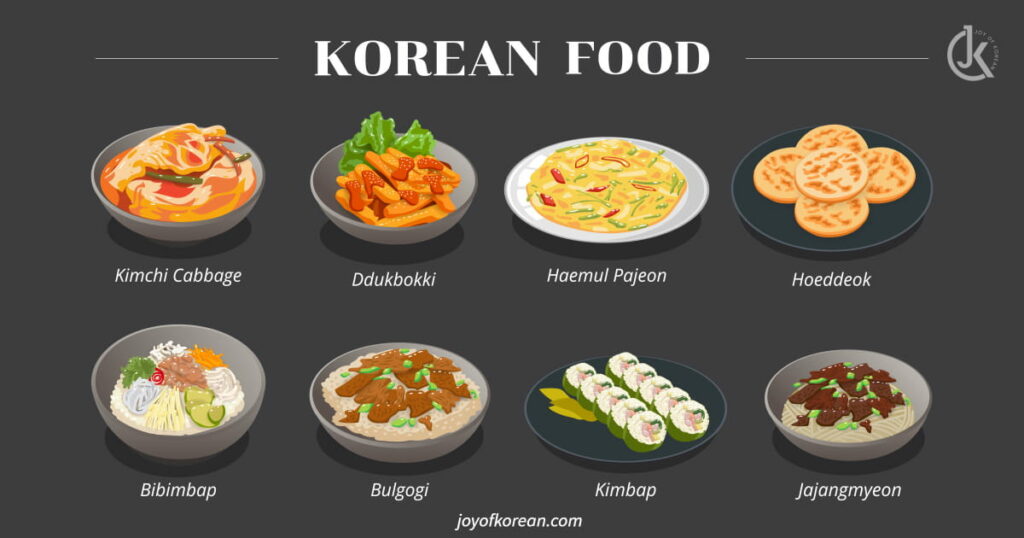
And if you are getting bored with the usual Kimchi. Well, you have hundreds of delicious Korean foods to choose from. There is something for every taste bud.
As a language learner, you may need to learn specific phrases, vocabulary, traditions, and food habits of South Korea. And what is better than diving deep into a fascinating world of Koreas dishes?
Understanding food items, recipes, and cooking can help you prepare for various Korean language tests like KLAT, EPS-TOPIK, and Standard TOPIK.
50 Must-Try Iconic South Korean Foods
So, whether you are a food connoisseur, a Korean language enthusiast, or simply curious about the culture. Well, bring your appetite and join us as we explore the 50 most famous Korean dishes that everyone should try once.
Go on and try. You know you can’t resist!
1. Kimchi (김치)
As Korea’s national dish, this spicy and sour was the obvious starting point.
Kimchi, which packs a delightful punch of spice and sourness, has a humble beginning. According to Korean historians, Kimchi originated in their country due to preserving vegetables during harsh winters.
What originated out of necessity is now a staple side dish in every Korean household. Traditionally made by salting and fermenting vegetables, Kimchi has been monumental in bringing Korea and its cuisine to the Western world’s attention.
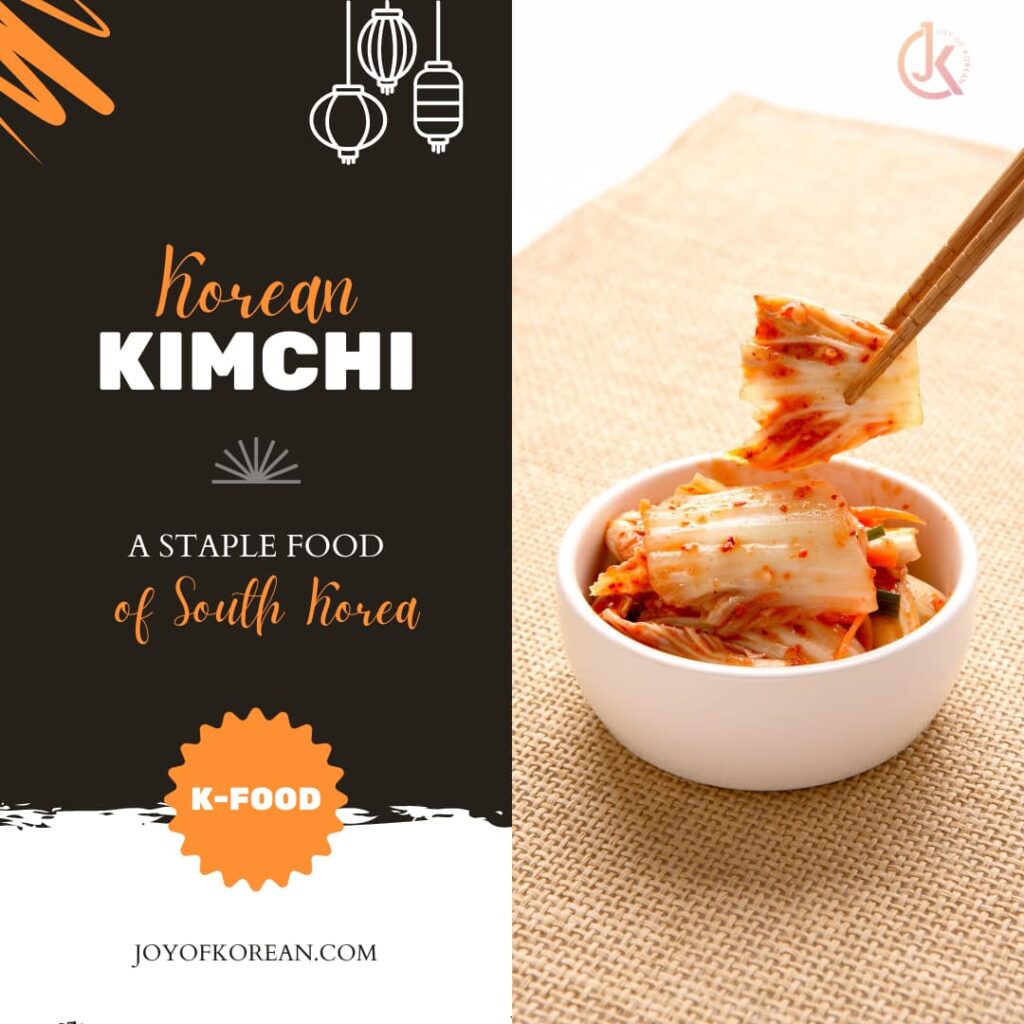
To put it simply, without Kimchi, every Korean meal is incomplete.
2. Hotteok (호떡)
In contrast to the typical desserts we eat in the western world, people in Korea consume sweet snacks/dishes to satiate their sweet tooth.
Hotteok is a savory and sweet pancake. With a crunchy exterior and a soft interior, this syrupy pancake gets its irresistible flavor from a sugary concoction that traditionally includes brown sugar, honey, chopped peanuts, and cinnamon.
People all over Korea enjoy it on cold winter days, freshly made hot off the griddle.
3. Sundubu-jjigae (순두부찌개)
What’s more satisfying than a steaming hot bowl of silky soft tofu and fresh vegetables cooked to perfection in a spicy broth of gochujang (chili paste) or gochu garu (chili powder)? Nothing!
This spicy stew is prepped and cooked directly in a large stone or porcelain serving vessel and then served bubbling hot with the addition of a raw egg just before serving to round out the flavors.
The adaptability of this dish is the best part: you can add any meat or vegetables to your choice, so each recipe is unique.
It pairs well with cooked white rice and is a dish that the whole family can enjoy together.
4. Naengmyeon (냉면)
The geographical location of Korea has a heavy influence on its cuisine. Koreans eagerly await the arrival of summer, so they can begin eating Naengmyeon – buckwheat noodles served in an icy cold starch broth.
It is prepared in a meaty or kimchi-based soup. It comprises long and thin handmade noodles, julienned cucumbers, carrots, and slices of sweet potatoes and pears.
Packing a powerful punch of varying textures and flavors, this dish is topped with vinegar and Korean mustard (gyeoja) just before serving to make it more refreshing. This light noodle dish works well as a light meal or a palate cleanser side dish.
Traditionally served in large brass or stainless-steel bowl, this simple yet tasty dish provides much-needed instant relief during Korea’s hot and humid summers.
5. Tteokbokki (떡볶이)
It’s the ideal dish to eat when the craving for something sweet and spicy hits. This soy-sauce-based mouthwatering snack consists of rice cakes cooked with scallion, soybean paste, fish cakes, and vegetables in a tangy chili sauce, with a great garnish of sesame seeds on top.
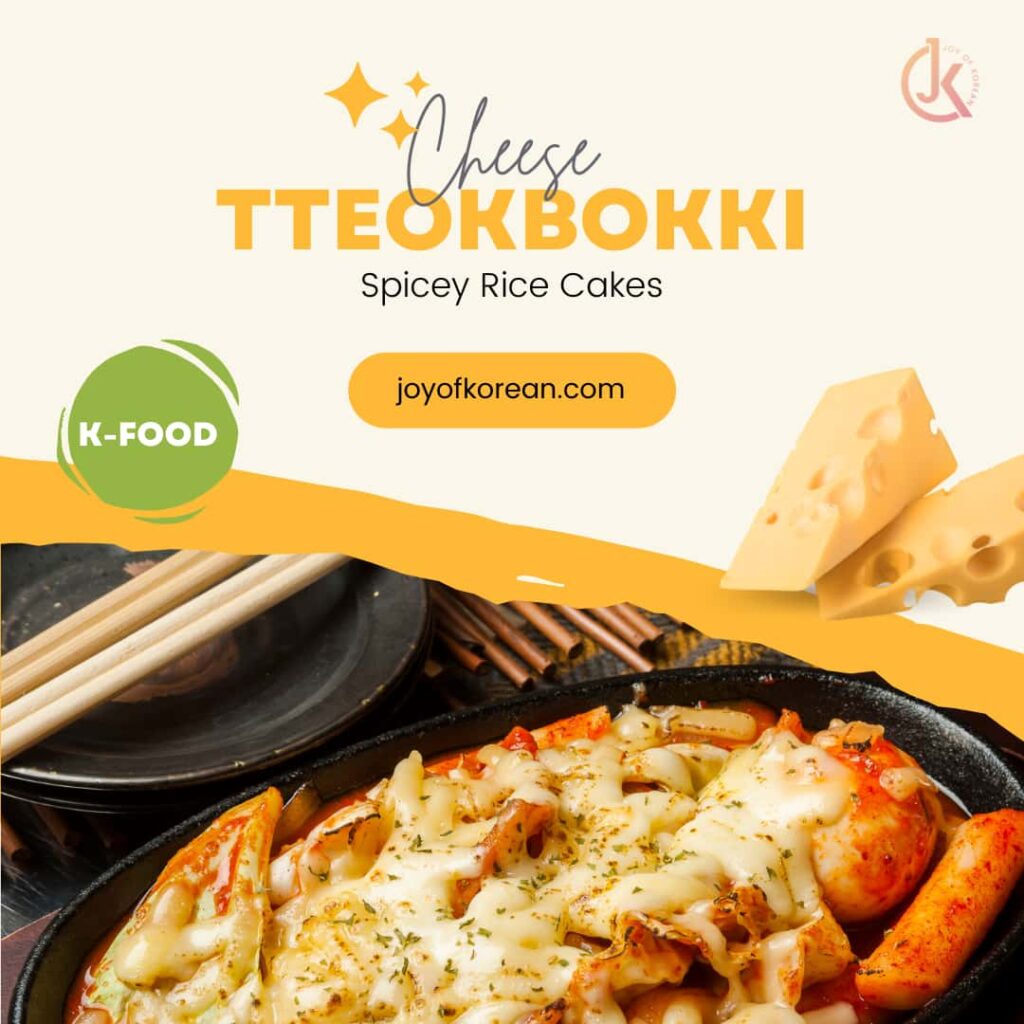
It is so popular among Koreans that they keep a bag of dry rice cakes in their refrigerator to make whenever the mood strikes.
This iconic red-orange snack and Kimchi have been instrumental in bringing Korean food to the forefront.
6. Gamja jorim (감자조림)
What happens when you braise succulent baby potatoes in an umami soy-based sauce to perfection? You get gamja jorim, a simple yet addictive side dish.
The name of this irresistible dish comes from its method of preparation. Baby potatoes are braised in the soy-based sauce until reduced and sticky. This cooking technique keeps the potatoes crispy on the outside and chewy inside. It is inexpensive to make and is incredibly filling.
This side dish is distinct in that it is neither pickled nor spicy, unlike other typical Korean foods. This tempting dish will undoubtedly leave you wanting more.
7. Bingsu (빙수)
With endless variations and an infinite combination of toppings, Bingsu is a summertime staple in Korea.
Bingsu is a variety of Korean shaved ice where a block of frozen milk or cream is grated to create a fluffy, cloud-like dessert. Icy yet creamy, it can be garnished with various sweet toppings that traditionally include red beans, tteok, chopped fruit, groundnut powder, and condensed milk.
Most bakeries and ice cream parlors stock up on traditional and contemporary varieties of Bingsu during summertime, where Koreans flock to find some respite from the heat.
8. Japchae (잡채)
Japchae is a traditional Korean glass noodle dish that tastes as good as it looks. This dry noodle dish is well-known for its appealing appearance, robust flavor, and chewy texture.
To make Japchae, cellophane noodles are stir-fried in a slightly sweet soy-based sauce and sesame oil along with an assortment of sauteed vegetables. The beauty of Japchae lies in its simplicity; flavors and textures can be incorporated into this dish by substituting ingredients for one’s choosing.
Once a royal dish, Japchae has become a popular side dish (banchan) associated with celebrations and special occasions in Korea. This is one of the must-try Korean dishes.
9. Haemul Pajeon (해물파전)
Haemul Pajeon is every seafood lover’s go-to meal: Crispy, flakey, and satiety!
Simply combine the seafood of your choice with a batter of rice flour and wheat flour, containing green onions, egg, and vinegar soy sauce. Then, pour it onto a skillet with hot oil and watch it come alive with a sizzle. The use of scallions as the essential ingredient gives this seafood and vegetable pancake its signature flavor.
Koreans make these pancakes on rainy days and pair them with a glass of cold Makgeolli (traditional rice wine).
10. Bibimbap (비빔밥)
Bibimbap is a dish best described as a hug in a bowl. The excellence of bibimbap, Korea’s most popular comfort food, is its customizability and ease of preparation.
Moreover, if you desire to make it more hearty, beef and a seasoned fried egg go exceptionally well with the assortment of ingredients.
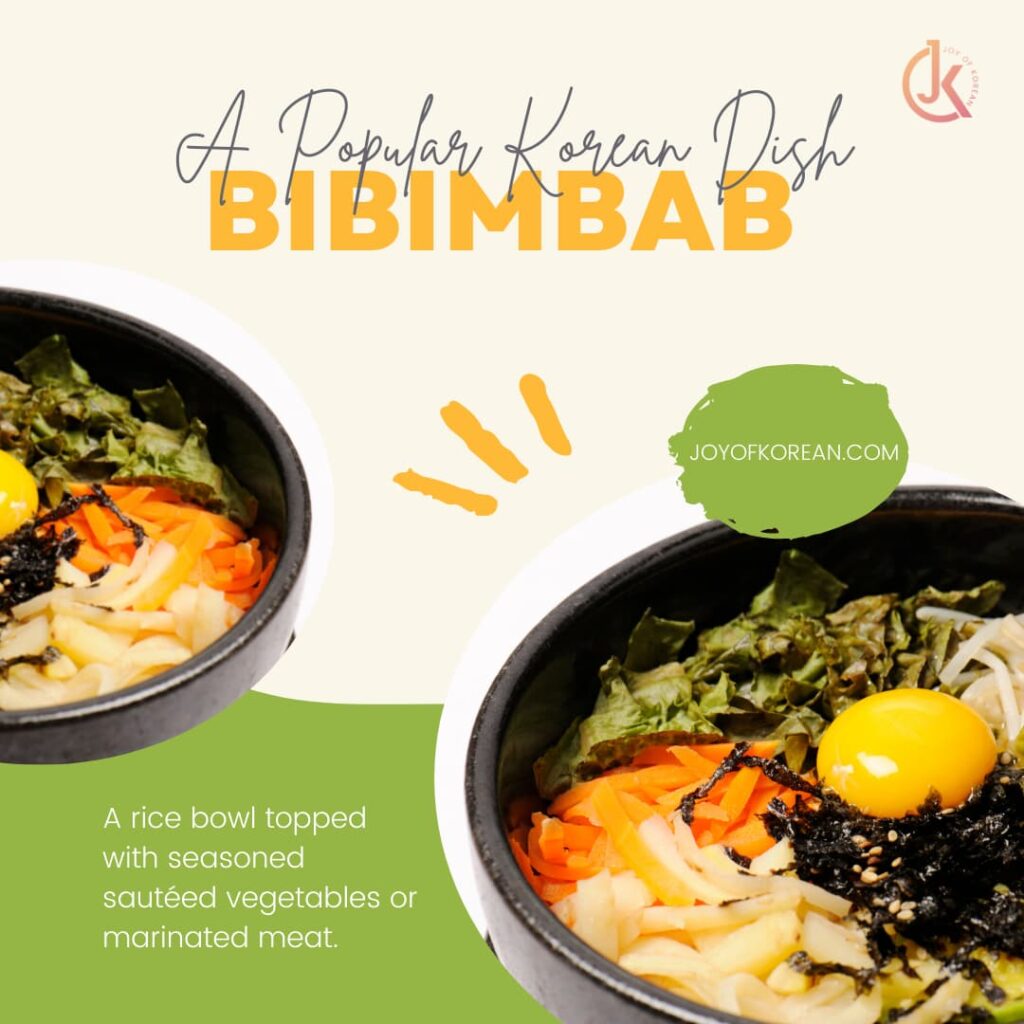
Bibimbap is one of the best Korean foods to try for the first time. So go on and enjoy it. You know you can’t resist!
11. Gyeongdan (경단)
Round and chewy, Gyeongdan is a type of tteok (rice cake). It’s a beloved Korean dessert made by kneading glutinous rice flour until soft and then shaping it into bite-sized balls.
Once cooked by boiling in water, they are coated with colorful powders- ranging from ground black sesame, mashed red beans, grated coconut to honey.
Modest and toothsome, Gyeongdan is the ideal dessert for serving and eating on special occasions.
12. Hobakjuk (호박죽)
In the chilly fall or cold winter days, nothing brings more comfort to the body and soul than a warm bowl of Hobakjuk.
Nutty and velvety on the tongue, this Korean oatmeal gets its trademark orange color and flavor from its main ingredient, pumpkin, and its creamy texture from the soaked gelatinous rice.
With its humble appearance and naturally sweet taste, it is commonly eaten as a light snack or a healthy breakfast. It is also considered a healing meal served to recovered patients in Korea.
13. Soondae (순대)
Many dishes in Korean cuisine will appeal to adventurous eaters. For example, Soondae is a blood sausage dish made by stuffing pig intestines with various ingredients, such as dangmyeon (transparent noodles), barley, soybean sprouts, and vegetables.
The heavy stuffing makes for a dense, somewhat gloopy texture. Plus, the condiments served to complement the meal differ depending on where it is served in Korea.
Sundae, which dates back to the Goryeo period in Korea, was once considered an indulgent food consumed during festivities.
14. Bossam (보쌈)
Bossam is essentially a steamed pork wrap. But don’t let the dish’s simplicity fool you; it’s a delicious bundle of goodness. Bossam is made by boiling pork meat in a flavorful brine containing garlic, ginger, and other aromatic herbs.
When the meat becomes tender enough, it is thinly sliced and wrapped in napa cabbage along with condiments like spicy radish salad and salted shrimp. It’s customary to eat this dish with Kimchi and dipping sauces; thus, it is always served with ssamjang or sauejeot.
The origins of Bossam are inextricably linked with Kimchi. This cooking and eating pork method began with kimjang when Kimchi was made in large quantities in preparation for the upcoming cold months.
15. Bulgogi (불고기)
Bulgogi translates to “fire meat.” It is a juicy, scrumptious Korean-style grilled meat dish. Thin beef or pork strips are marinated in a mixture of soy sauce, sugar, and various other ingredients before being grilled on a grill.
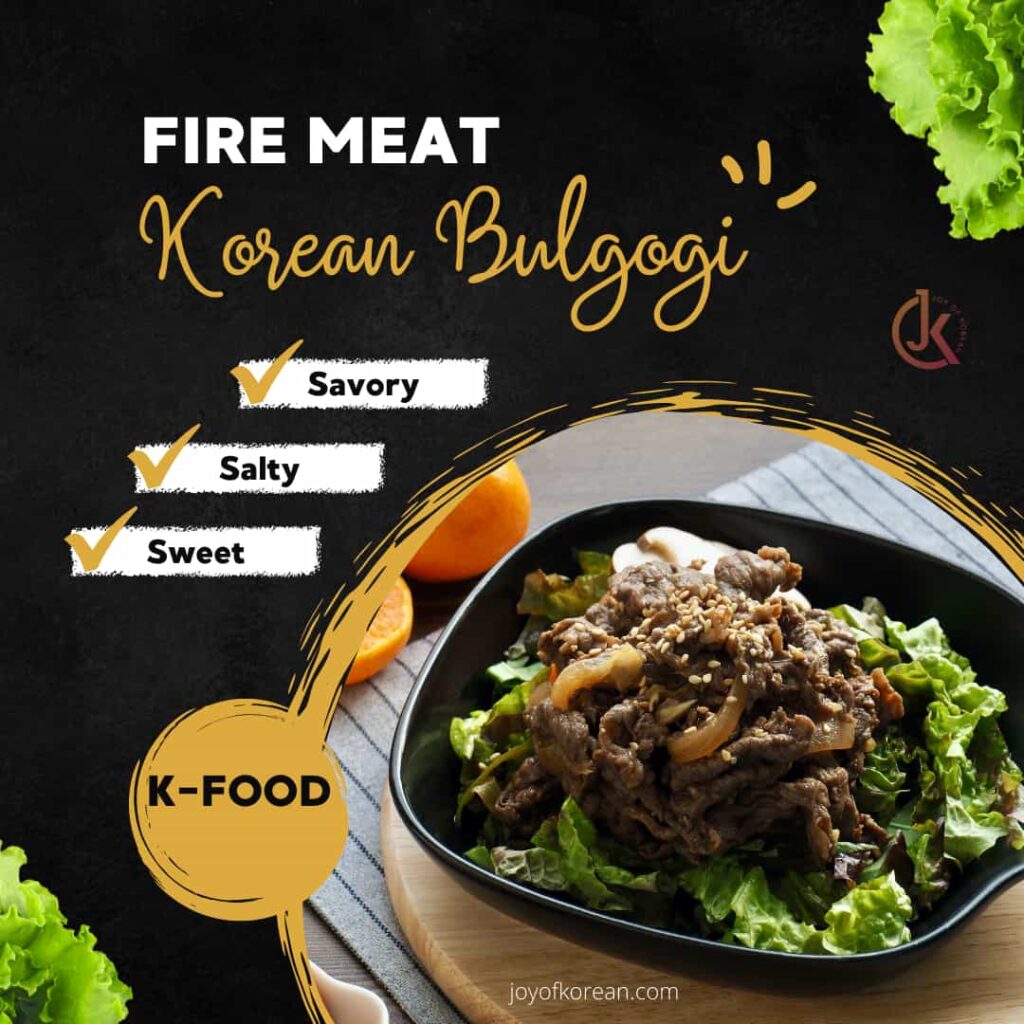
This tender meat dish cooks in seconds and goes well with rice, lettuce, and red pepper paste (ssamjang). Due to the immense demand for this dish, it can be found everywhere – from fine dining restaurants to street-side kiosks.
Bulgogi can be consumed at any time of year. Still, most Koreans make and enjoy this barbeque dish on special occasions or in social settings. This dish provides an excellent opportunity for family and friends to cook and dine together.
16. Baechu-doenjangguk (배추된장국)
Baechu-doenjangguk is a Korean soybean paste packed with napa cabbage, vegetables, meat, and seafood.
The straightforward recipe came from fermented soybean paste, a staple Korean condiment. It can be best understood as the more homely, soupier, and lighter version of doejang-jjigae.
This soup is prepared more frequently during the late fall season in Korea, when napa cabbage is available in abundance. It’s great with rice or as a side dish for more complex one-bowl dishes.
For the ultimate comfort meal, serve it with a bowl of steamed white rice and some Kimchi.
It is an absolute must-try Korean dish.
17. Seolleongtang (설렁탕)
Seolleongtang is an ox bone soup made with inexpensive meat cuts and sparse ingredients, culminating in a rich, creamy, and nourishing soup.
The ox bones and other cuts of meat are simmered over a low flame for several hours, allowing the flavor of the bones to slowly infuse into the soup. Although time-consuming to prepare, the result is worth the wait: a creamy, milky white soup packed with nutrition.
The soup is served plain, without seasonings. Traditionally, the condiments are added at the table: at most, this dish contains chopped green onions, minced garlic, and julienned garlic.
This brothy soup is a staple at Korean homes during winters. It is also used as a base for other dishes to amplify their flavors.
Nothing beats a hot bowl of freshly made Seolleongtang, seasoned to taste with salt and pepper and paired with a simple bowl of steamed white rice and kkakdugi (radish kimchi).
18. Hwajeon (화전)
Hwajeon is not your average dessert; it appears to be more of a work of art than a dessert. It’s a one-of-a-kind pan-fried rice cake dessert with a chewy texture and delicate floral aroma.
It is made by kneading glutinous rice flour dough into a flat disc shape and garnishing it with edible petals of seasonal flowers. These are traditionally made in the spring with Korean azaleas, pear blossoms, rose petals, and wild chrysanthemums.
The creation of Hwajeon is steeped in history. Hwajeon is thought to have originated during the Koryo Dynasty, when it was consumed at Hwajeon Nori, a traditional picnic where women would socialize and engage in recreational activities.
Whether the season or the flower, these cakes are a sensory delight for everyone!
19. Dasik (다식)
In terms of variety and range, Korean sweets give a stiff competition to the western desserts.
Dasik is a traditional Korean honey cake that is meant to be eaten as a sweet counterpoint to the bitter taste of the tea.
This elegant and bite-sized Korean confectionery is made by kneading edible grain and seed powder with honey (chestnut, pine flower, bean, starch, and sesame powder). It is then pressed into decorative molds (dasikpan) to emboss beautiful patterns on Dasik.
These delicate cookies with natural color and flavoring taste just as good as they look. They have a slightly sweet flavor and tender texture. The ingredients are available in white, yellow, black, green, brown, or reddish shades.
Dasik has cultural significance; they represent good health and fortune and are made for the Lunar New Year and served to honor guests.
20. Samgyetang (삼계탕)
It’s simply impossible to resist an iconic soup dish like Samgyetang, which is not only nutritious but also creamy and meaty. It’s a gummy, thick soup made by stuffing a whole young chicken with ginseng, garlic, rice, and jujube.
Simmering the tender chicken in water for hours to make the broth thick subdues the natural bitterness of ginseng, leaving a palatable flavor that permeates through the juicy, boiled-down chicken meat.
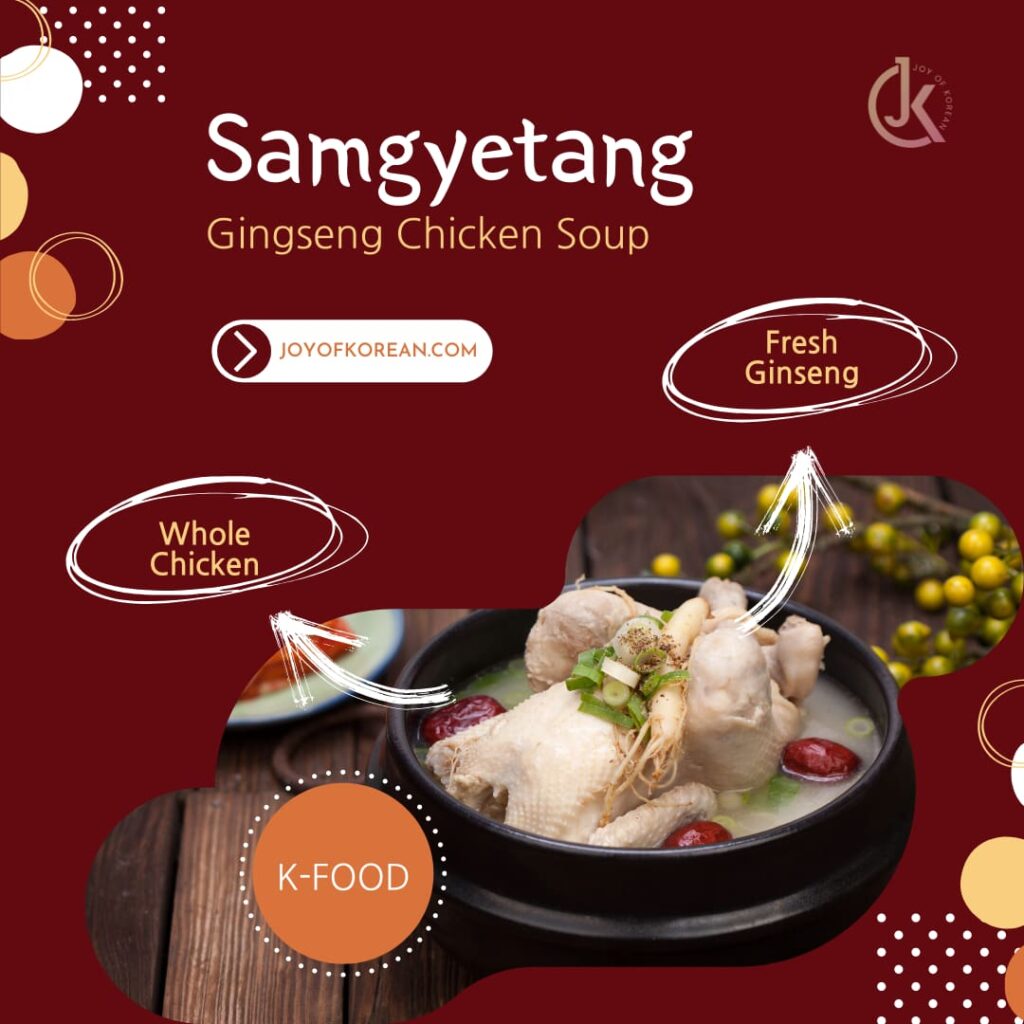
Korean ancestors believed in “Yi yeol chi yeol,” which translates as “fighting fire with fire.”
This implies that they eat hot meals like Samgyetang as stamina food during the three hottest days of July and August to replenish nutrients lost through sweat and physical activity. This allows them to balance their body heat with the outside temperature.
21. Mandu (만두)
When it comes to Lunar New Year conventions, eating Mandu is an inseparable part of the festivities. Delicious and light, making and eating Mandu with the family is considered a symbol of good luck for the coming year.
Mandu is a generic term for Korean dumplings with a savory filling wrapped in thin, elastic wrappers. The fillings vary according to personal preference, making this dish genuinely versatile.
Mandu can be prepared and consumed in any way one desires. They can be steamed, pan-fried, boiled, or deep-fried and incorporated in many recipes.
They are substantial enough to be eaten as a meal, but they’re also great as a snack, appetizer, or banchan. Mandu tastes best when paired with a bit of dipping sauce and a side of Kimchi.
22. Chimaek (치맥)
Chimaek results from the marriage of two popular Korean foods: beer and chicken, served together as Anju (food consumed with alcohol).
Korean fried chicken is double-fried, which results in a crunchier flavor and less greasy skin, resulting in an overall improved flavor.
Because of Korea’s dedicated drinking culture, Chimaek is preferred over eating chicken or drinking alcohol alone and is a popular order among Korean youth.
23. Chueotang (추어탕)
Chueotang is a delectable chowder made from pond loach, a type of freshwater mudfish (chueo). What makes this dish extraordinary is that the fish is boiled, ground, and mashed into the soup until it is unidentifiable, resulting in a coarse yet satisfying stew-like consistency.
This spicy dish is made with mudfish, soybean paste, ginger, and other common flavorings such as fried tofu, noodles, mung bean sprouts, dried radish greens, and sweet potato stems.
It is seasoned with gochugaru and doejang, ensuring that you get the best of health and rich flavor in every bite.
Koreans believe that this dish provides vitality and are eager to devour bowls of Chueotang whenever the opportunity arises.
You may also like to read → (i) study abroad in Korea (ii) GKS UG (iii) GKS PG (iv) Korean translator jobs (v) Jobs for Korean speakers.
24. Gyeran Mari (계란말이)
Gyeranmari, or rolled omelet in Korean, is a light and savory banchan. It’s made with lightly beaten eggs and various readily accessible ingredients, like scallions, carrots, mushrooms, zucchini, or nori seaweed. Then, all finely diced to add different textures to the dish.
After rolling the fluffy, cloud-like omelet, it is sliced and served. It is a trendy lunch box item in Korea and is also eaten as Anju.
It is lightly seasoned with salt and pepper and is served at room temperature with spicy dishes to neutralize the heat.
25. Kimchi Jjigae (김치찌개)
Kimchi, as a dish, is a gift that keeps on giving. While Kimchi undeniably is the dish that catapulted Korean foods to the limelight, its derivatives, such as Kimchi Jjigae, stand out on their own.
Kimchi Jjigae is no ordinary stew; made from aged Kimchi, it is tangy, spicy, savory, and altogether delicious.
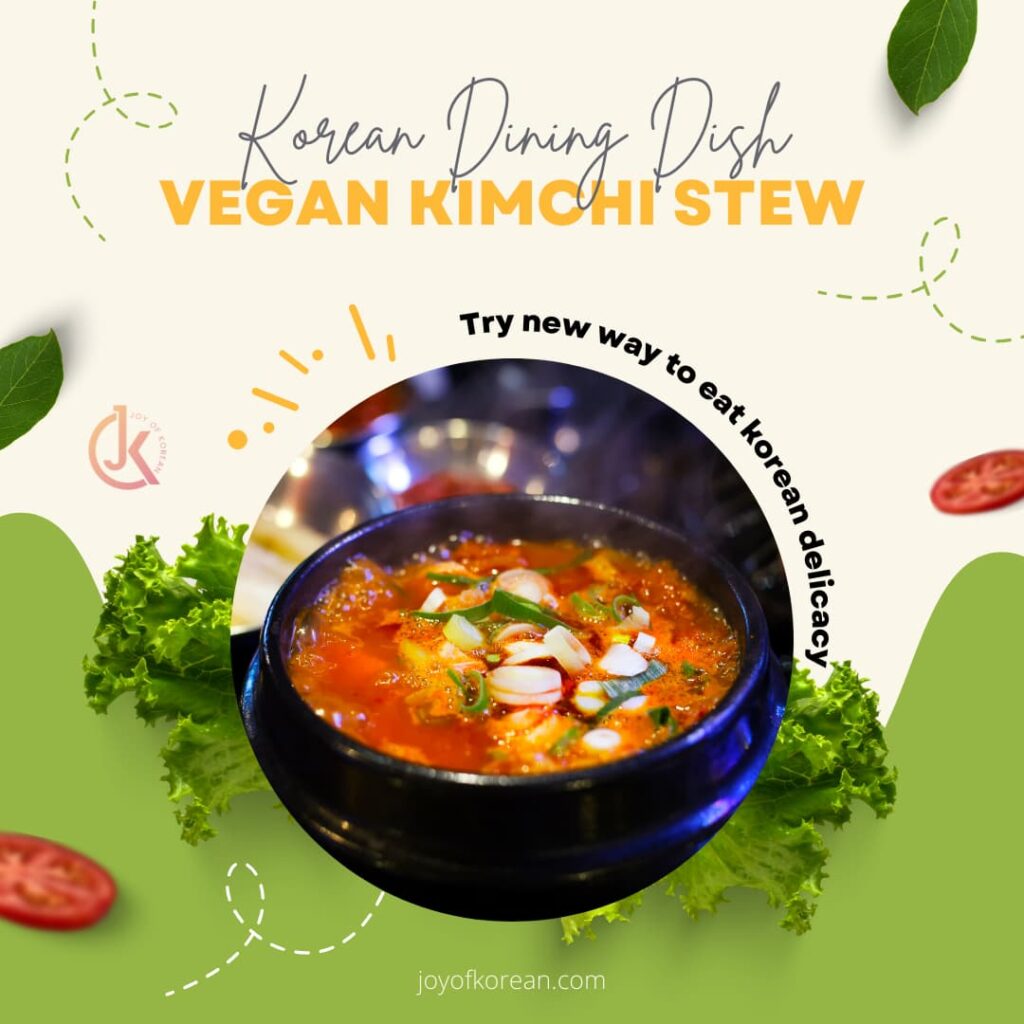
Kimchi’s flavor profile becomes denser as it ages-imparting a more ripe and fermented flavor to the dish. With Kimchi as the main ingredient, the rest of the ingredients are entirely up to personal preference. This stew is usually made with doenjang, gochujang, tofu, and sliced onions cooked in either anchovy stock or water.
Eaten with rice or as a stand-alone meal, it simply hits the mark every time.
26. Tteokguk (떡국)
Tteokguk was initially reserved for Lunar New Year to commemorate the passage of another year. However, it has since evolved into year-round comfort food.
Drinking this clear, meaty soup on Lunar New Year is considered auspicious in Korean culture. This is because it heralds the coming of wealth and long life as the year progresses.
The ingredients for this soup vary depending on the family. Still, standard components include shredded omelet, dried seaweed, scallions, julienned ginger, and on occasion, dumplings. Tteokguk is a quick dish with simple flavors that everyone enjoys.
27. Gyeran-ppang (계란빵)
If you’ve got a sweet tooth, you’ll adore this one!
Gyeran-ppang is a tasty, albeit peculiar, street-side snack. It is essentially a sweet and fluffy bread made from pancake dough with a whole, cracked egg.
The salty flavor of the egg perfectly complements the sweet taste of the bread.
With its pleasant aroma and delicate texture, it always hits the spot. This makes any dinner table sumptuous.
28. Kongguksu (콩국수)
Kongguksu is a seasonal Korean dish that takes some getting used to. However, this cold and creamy noodle dish will quickly become your favorite summer meal once you foster a taste of it.
This refreshing dish is prepared in a soybean milk broth, imparting a snow-white color and a subtle nutty flavor.
It is served ice-cold with a garnish of julienned cucumbers on top. So not only is it highly nutritious but also vegetarian-friendly.
29. Ganjang gejang (간장게장)
Ganjang gejang, a dish made with fresh raw crab marinated in a mild soy-sauce based brine, has taken Korea by storm.
This dish with a slightly bitter and tangy flavor may surprise first-timers. Still, it quickly becomes addictive to the palate.
The marinated crab meat, which becomes salty and nectarean due to the marinade, is served as a main course. It tastes best when eaten cold, and when paired with steamed white rice, the combination is divine.
30. Gopchang (곱창)
Korea has a well-established barbeque culture. Gopchang, a grilled meat dish, is an integral and vital part.
The textural contrast that distinguishes Gopchang from other grilled meats is what makes it supreme. Small intestines from either pork or cattle are chopped into rounded sections and grilled.
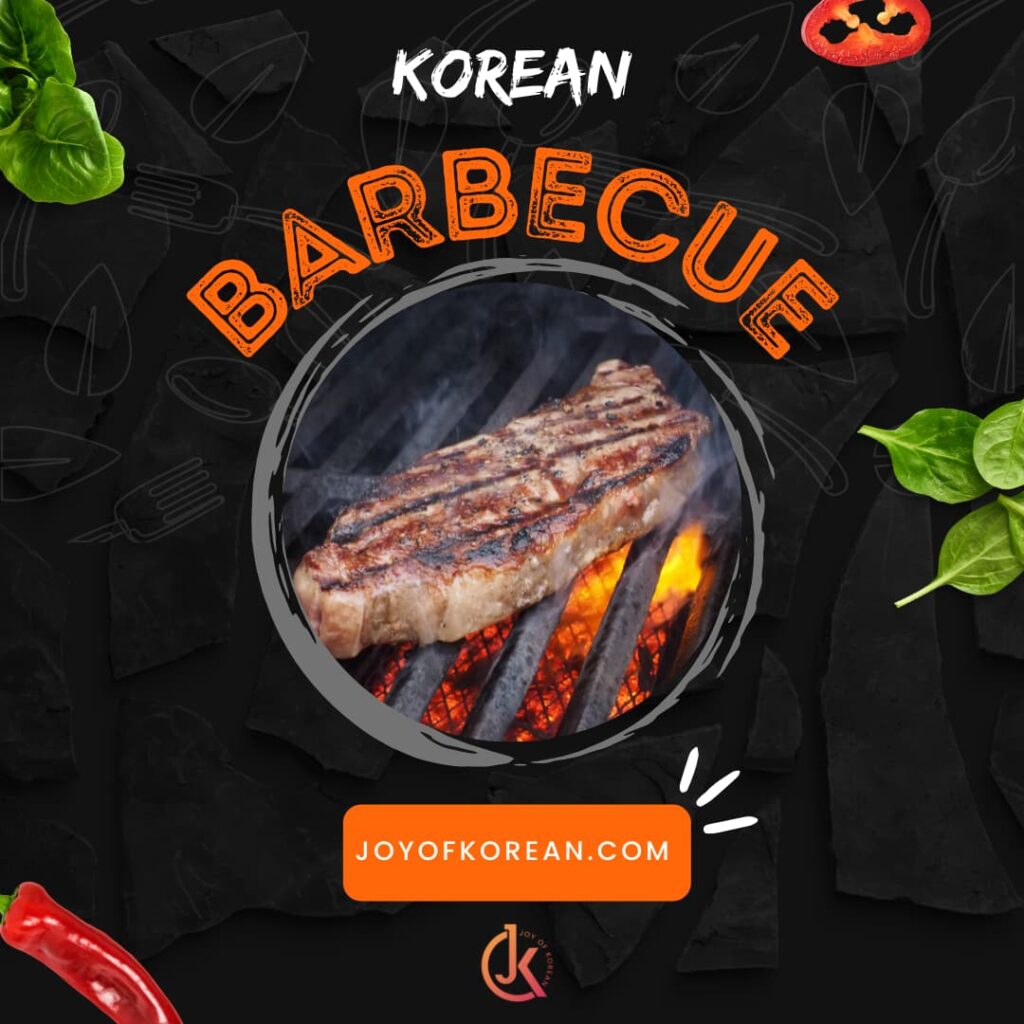
This results in a crisp golden-brown exterior and a buttery-tasting, chewy, soft inner meat. It is classed as a delicacy and is prepared in various ways, including soups, stir-fry, and grilling.
Gopchang is typically served with a garlic-infused soy sauce. In addition, it is customarily paired with a glass of chilled Soju. It is a divine combination that shouldn’t be missed out on.
31. Gamjatang (감자탕)
Korea’s dedicated hangover cure dishes result from the country’s authentic drinking culture. For example, Gamjatang is a spicy soup famous as an effective hangover remedy across Korea.
It is made using pork bites, potatoes, vegetables, and perilla seeds, simmered in pork bone broth seasoned with Korean condiments.
The addition of perilla seeds lends this dish a distinct flavor. When served with rice, the rich flavor from the fatty meat makes for a complete meal.
32. Nakji Bokkeum (낙지볶음)
Nakji Bokkeum is a spicy and flavorful stir-fried octopus dish that will hook you from the first bite.
Although Korean cuisine is full of spicy dishes, Nakji Bokkeum takes things to the next level.
Because of its extreme spiciness, it is always served with rice, boiled noodles, or soybean sprouts to balance out the heat.
33. Sikhye (식혜)
Sikhye is the perfect drink for internally cooling the body after a spicy meal. This traditional Korean sweet punch is made from fermented rice and malted barley powder and garnished with pine nuts.
Aside from its cooling effect and enticing grainy texture, it is also known to aid digestion.
This makes it a popular dessert served after a hearty meal on holidays and feasts.
34. Budae Jjigae (부대찌개)
Necessity is the mother of all inventions, and need can sometimes create a tasty and appetizing dish, like Budae Jjigae. This Korean fusion dish was invented to counter the food scarcity after the Korean War (1950-1952).
It combines elements from Eastern and Western cultures, such as canned ham and sausage, to create a medley of flavors that appeal to the Korean palate.
Budae Jjigae is essentially a one-pot stew made with sausages, spam, cheese, tteok, ramen noodles, Kimchi, and assorted vegetables in a tangy and spicy broth. This addictive high-calorie dish has now a staple of Korean cuisine that no one can get enough of!
35. Samgyeopsal (보쌈)
Koreans have a penchant for fatty cuts of pork. So it goes without saying that they enjoy Samgyeopsal, which is a type of Korean pork barbeque.
The authentic flavor of this dish comes from grilling the meat in its fat, without any marination or added seasonings. Instead, the cooked meat is dipped in sesame seed oil and seasoned with salt and pepper.
Another significant aspect of Samgyeopsal is that it is intended to be grilled by the diners to their personal taste, along with the vegetables, making it a well-rounded meal.
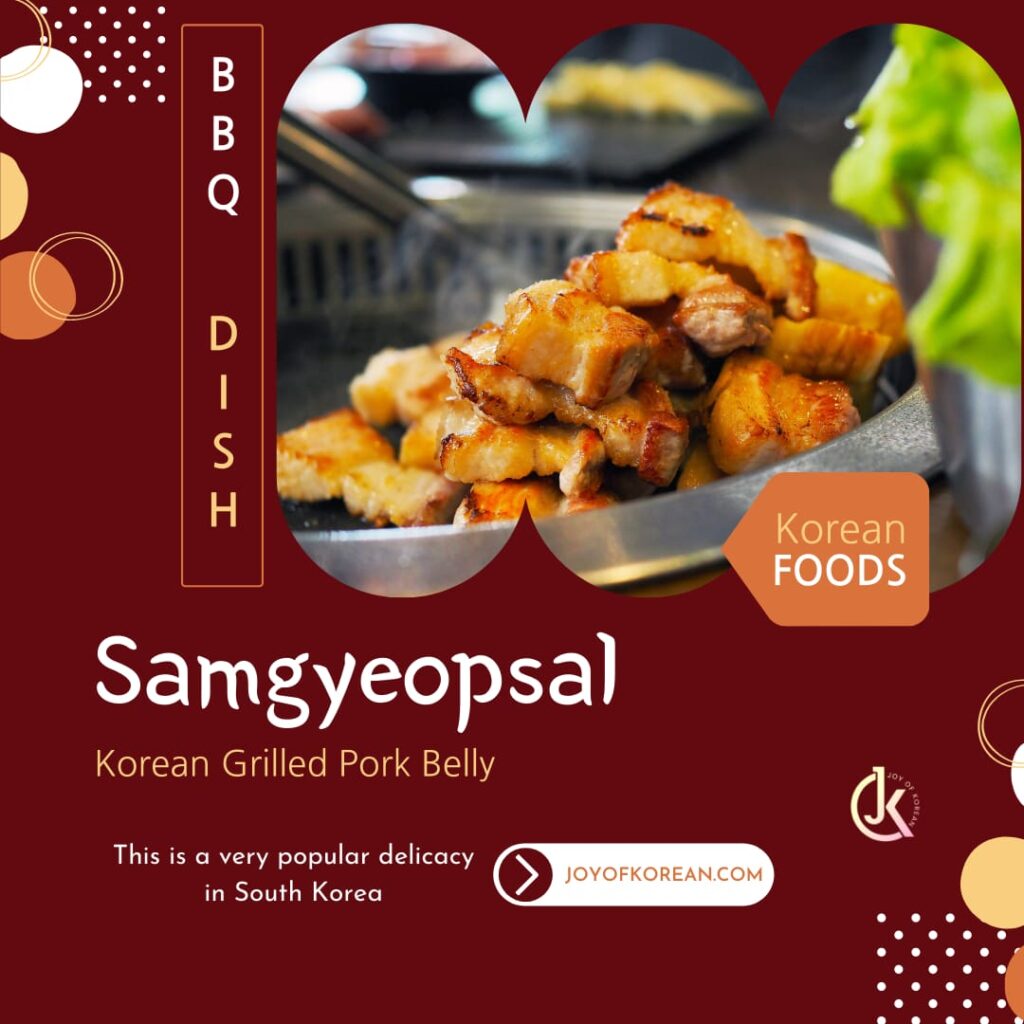
This is typically consumed in large gatherings with a myriad of side dishes, condiments, and dipping sauces. People also like to drink Soju (Korean alcoholic beverage) with it.
Samgyeopsal is so highly regarded in Korea that March 3rd is designated as Samgyeopsal Day to promote pork belly barbeque consumption.
36. Kalguksu (칼국수)
Kalguksu is a Korean dish made with knife-cut wheat noodles. Manually cutting the noodles results in a chewier and more bouncy texture superior to processed or spun noodles.
Kalguksu is all about simple flavors; dried anchovies, shellfish, kelp, and mushrooms are simmered for several hours to make the broth. Then, the flat noodles and vegetables are boiled together.
This light and soothing soup are perfect for lifting your spirits on any given day.
37. Bindaetteok (빈대떡)
Bindaetteok is a flat mung bean pancake made from pan-frying a ground and seasoned mung bean mixture with vegetables and meat.
These pancakes are best eaten hot, straight from the pan, to fully appreciate the vegetables’ nutty flavor and satisfying crunch.
These delicious pancakes served with a special dipping sauce made with vinegar, pine nuts, and soy sauce are popular street food in Seoul.
38. Omija Cha (오미자 차)
Nothing beats Omija Cha in terms of flavor complexity. It is a tea that is made from dried Magnolia Berries. These berries impart a sour and sweet flavor to the tea, with hints of bitterness, saltiness, and pungentness—hence the name Omija. (meaning five in Korean)
This tea is made by boiling the berries in water and steeping them overnight. The brewed tea can be drunk hot or cold throughout the following day after adding honey.
This tea is well-known for its medicinal properties and its distinct flavor. It is recommended to drink Omija tea during the summer because it helps people cope with the heat.
39. Agujjim (아구찜)
Agujjim is a seafood dish made by braising blackmouth anglerfish and soybean sprouts in a spicy sauce. The blend of different chillis used in the seasonings gives this dish its unique fiery red color.
This dish was created in the 1960s to use unusual-looking fish so that their meat would not go to waste. Anglerfish, also known as “beef of the sea,” is a high-protein source with a chewy texture that complements the crunchy soybean perfectly.
This dish has gradually carved out a niche for itself over the years and is now enormously popular in Korea.
40. Jjajangmyeon (짜장면)
Originally a Chinese dish that evolved over time to suit the Korean palate, Jjajangmyeon has cemented its place as a treat to commemorate special occasions in their lives.
It is a Korean dish wherein stringy, and chewy noodles are layered with a thick and savory sauce with dominating flavors of chunjang (black bean paste). This is typical cooking aromatics, added with soy sauce, diced pork, and vegetables.
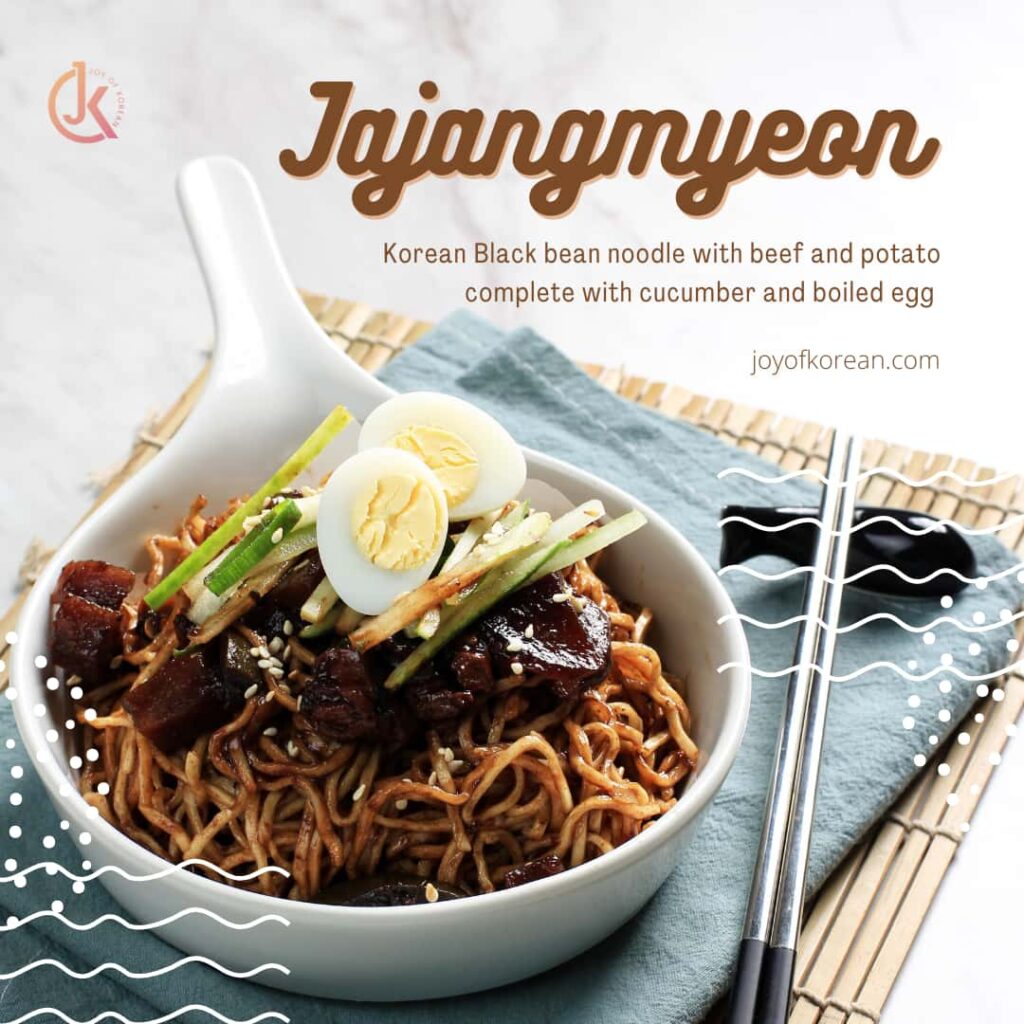
Cucumbers and yellow radish are added to the dish just before serving to add a layer of crunch and freshness. Koreans love this carb-heavy, umami-laden dish so much that they eat it at least once a week.
41. Gyeran Jjim (계란찜)
Gyeranjjim is the ultimate antidote to spicy food. It’s a traditional Korean steamed egg dish with a custardy, casserole-like texture and a pudding-like consistency.
It is lightly seasoned with scallions and sesame seeds and is kept mild in flavor. It is primarily served with spicy main dishes to help with the heat.
Gyeranjjim is a popular side dish to cook and serve because it is quick to prepare and easy to digest.
42. Yakgwa (약과)
Yakgwa is a sweet pasty or cookie that evolved from being considered medicine to a sweet snack in Korea. In fact, this dish derives its name from its use as a medicine in the past.
It is a wheat-based delicious confectionary dipped in a honey and ginger concoction post-deep-frying. Crumbly in texture and sugary in flavor, these round cookies get their traditional floral patterns from being pressed in a yagwapan.
Yakgwa requires time and patience to make, but it is well worth the effort. It is now considered a must-have sweet during ceremonies, holidays, feasts, and rituals.
43. Songpyeon (송편)
Songpyeon is a traditional half-moon-shaped tteok (rice cake) with sweet or semi-sweet fillings, such as sesame seeds, black soybeans, or mung beans.
These rice cakes are conventionally steamed over a bed of pine needles, imparting them a subtle pine aroma and patent taste. To make them more visually enticing, they are frequently flavored with natural colorings, including kabocha, dried fruit powders, etc.
The cultural significance of Songpyeon makes it one of the most famous traditional Korean sweets.
Preparing and eating these sweet rice cakes with the family is quintessential to expressing gratitude for good health and fortune during the celebration of Chuseok, the Korean moon harvest festival.
44. Jjambbong (짬뽕)
It takes one bite of Jjamppong to realize what one has missed in life. Jjamppong is a spicy, brothy noodle dish with seafood or a pork-based base. The main flavoring in this dish is Gochugaru, which adds a lot of heat.
Other common dish additions include julienned vegetables, squid, clams, and mussels. This dish originated in China but has since been adapted to the likening of the Korean palate. It incorporates ingredients with a spicy and smokey flavor.
The blend of spice from the chili powder and the slight sweetness from the sliced onions is the dish’s actual highlight. Jjamppong is the ideal dish for rejuvenating one’s senses on rainy and windy days.
45. Gimbap (김밥)
They say we eat with our eyes first. In this case, Gimbap trumps all other foods. It is one of those Korean dishes that looks too pretty to eat once it’s finished.
Gimbap (also called Kimbap) is mainly known as Korean Sushi due to its uncanny visual resemblance to the Japanese delicacy, but the similarities end there. Gimbap is Korean-style Seaweed Rice Rolls.
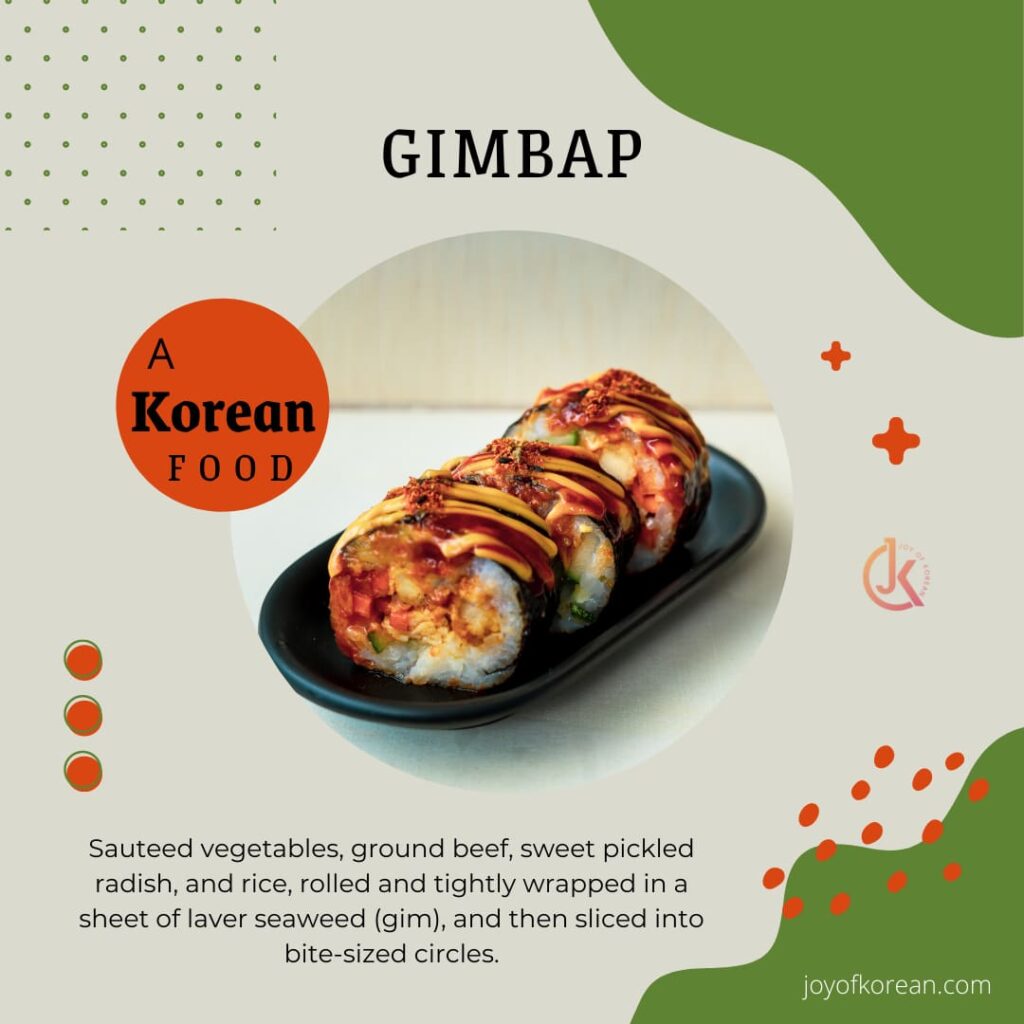
Seasoned short-grain white rice and sweet pickled radish with other versatile fillings are carefully wrapped into tight rolls using a sheet of dried seaweed (gim).
Then it is sliced into bite-sized circles. It is topped with white sesame seeds before serving and often accompanied by dipping sauce or Kimchi as a side dish.
Gimbap is a food you can never have enough of because of the limitless stuffing options. This dish is also a brilliant way to use up leftovers. Gimbap is a popular snack that can be enjoyed in many settings: as takeout meals, on picnics, hiking, and even as a party appetizer, owing to its aesthetics and convenience of portability.
46. Dubu Jorim (두부조림)
Dubu Jorim is a spicy braised tofu dish. For vegetarian Koreans, this is the go-to dish.
To make Dubu Jorim, tofu is lightly seared and braised in a savory and spicy soy-based sauce before pan-fried with caramelized onions, garlic, and green onions.
The crispness of the vegetables, the softness of the tofu, and the sauce’s spice create a perfect assortment of flavors in this quick-to-whip-up, one-pan dish.
It is also a popular option for school lunches. It is commonly served over rice or noodles when eaten as a meal.
47. Galbijjim (갈비찜)
Galbijjim is a traditional Korean braised short ribs dish.
The tender and succulent meat is the star of this dish, cooked in a flavorful sauce made with honey, mirin, apples/pears, and other common condiments like ginger, garlic, onions, and soy sauce. It is usually served with rice as the main course.
This stew was once considered an exotic dish prepared only on special occasions. But it has since evolved into standard comfort food.
48. Dotori-muk (도토리묵)
Dotori-muk is an acorn starch-based jelly. It’s a low-calorie dish with a slightly bitter, earthy taste. This dish was created to use the plentiful acorns produced in Korea’s mountainous regions each autumn.
Before serving, it is cut into squares and seasoned with a spicy and tangy sauce. Dotori-muk is a viable lunch option to pack when traveling long distances since it doesn’t spoil quickly.
Whether you’re a fan of Korean recipes or have reasons for studying Korean to dive deep into the intriguing planet of K-food, you will surely love this.
49. Injeolmi (인절미)
Injeolmi is a type of tteok (rice cake) made from pounded glutinous rice that has been steamed. It has a mildly sweet flavor, a chewy texture, and a sticky texture.
After shaping into bite-sized chunks, these rice cakes are frequently coated with soybean powder, black sesame seed powder, mashed red beans, and other ingredients.
It is considered a high-quality tteok and is only consumed on special occasions and festival days.
50. Dalgona Candy (달고나)
This list would have been incomplete without mentioning dalgona candy, which has been on everyone’s mind lately.
Dalgona candy, also known as ppopgi (뽑기), is a toffee-like Korean honeycomb candy. It’s a caramel-flavored sponge candy that melts in your mouth when you bite into it.
Dalgona is made with only two primary ingredients: sugar and baking soda.
From the 1960s to the 2000s, it was popular street food and is still eaten as a nostalgic food in Korea. However, its recent resurgence and global recognition can be attributed solely to Netflix’s Squid Game, one of the best k dramas for learning Korean.
Simple and inexpensive, Dalgona is genuinely a fun candy to eat!
Final Words on Top Korean Foods Guide
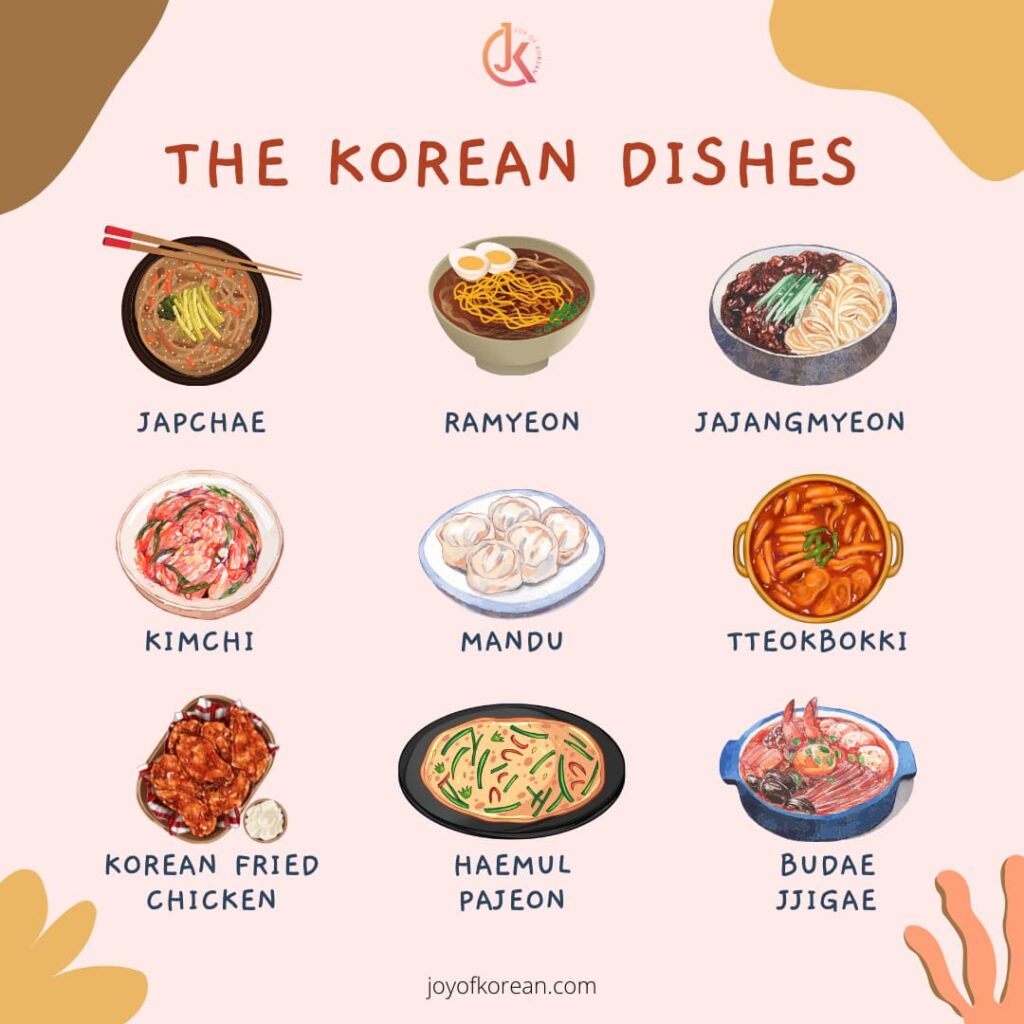
Eating is one of the most beautiful joys of traveling in South Korea. And no trip is complete without pampering in the sumptuous delights of Korean foods.
You also know more about Korea and get a vivid insight into each region’s culture, customs, and food habits.
Korea is home to an enormous number of traditional and modern dishes. And the above list of Korean foods can surely please your hunger, crave, and match your taste.
Regardless of your preference, you will find nearly everything in Korean meals.
Along with that, as the icing on the cake, you get to learn an awful lot from them. For example, tradition, history, vocabulary, and sentence formation, to name a few.
It’s no secret that your Korean language skills will grow more if you taste or study more about Korean dishes. So, don’t forget to benefit from it.
To write this piece one of its kind, we (me and Vikash Gupta) endeavored to keep our horizons open to compile the variety of Korean foods across the board.
As an avid foodie and Korean lover, I couldn’t resist the temptation of putting together a list of 50 of the best Korean dishes.
Of course, this is an entirely subjective selection, so feel free to tell us in the comments which Korean foods you like the most or any suggestions you may have for us!
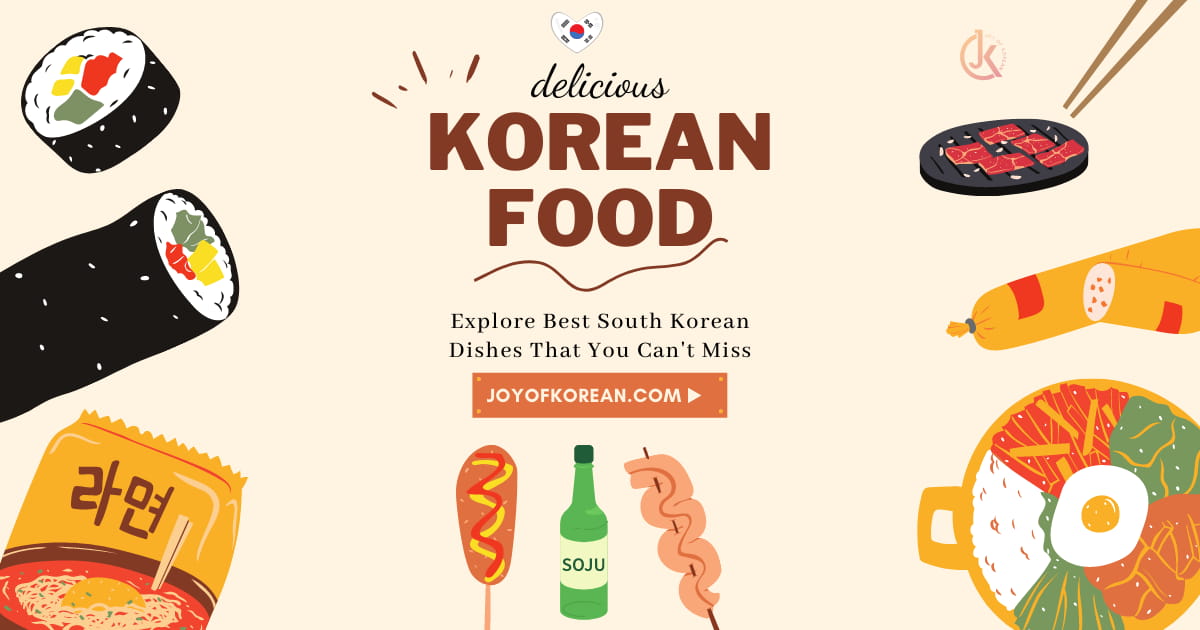






I think your website is WONDERFUL. It reminds of my day on S. Korea when I was in the Army. Please SIGN me up to receive emails from your company.